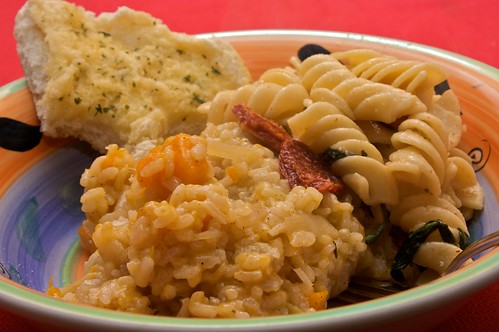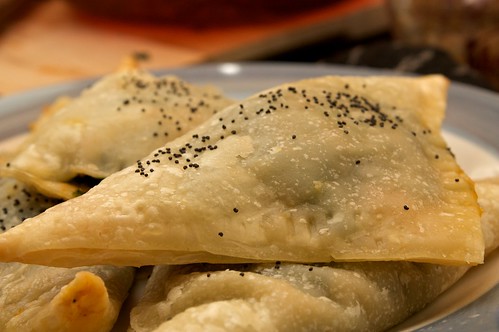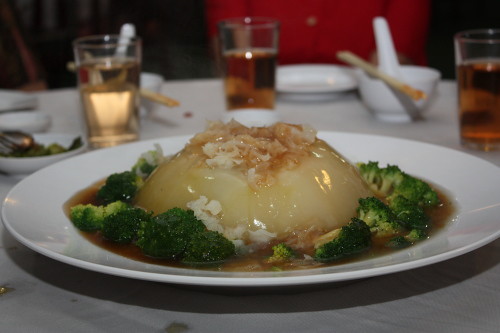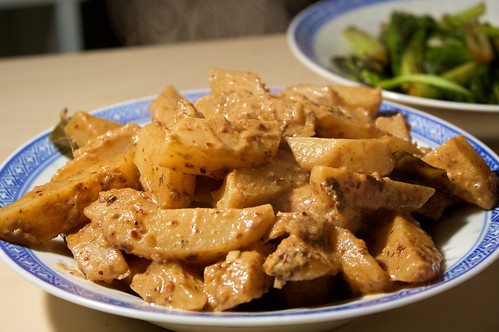Sunday, 17 August 2008
Friday, 15 August 2008
pumpkin and leek risotto
D’s youngest brother came to dinner last night. Since their parents have been away, all he’s been eating is frozen dinners and takeout, because the only thing he claims to be able to cook is enchiladas, and he has run out of corn tortillas. Unfortunately, he hates mushrooms, so at the last minute I had to revise my original dinner plan and replace it with a pumpkin and leek risotto, which I served with a spinach and sundried tomato pasta salad, and garlic bread.

I don’t know how N felt about it all, but I’m really happy with how the risotto turned out.
pumpkin and leek risotto
Boiling the pumpkin and then frying in a frypan makes the pumpkin soft but crispy. This is also an awesome way to prepare pumpkin for pizzas. If your preference is for roasting instead, feel free, but it will add a little bit to the overall cooking time.
ingredients
one pumpkin (in small cubes)
sage
a shake or three of ground nutmeg
pinch of thyme
two cups arborio rice
five cups stock
half red onion
one leek (white part only)
one clove garlic (minced)
method
Boil the pumpkin until almost cooked, then fry in a fry pan for five or six minutes.
Dice the onion, and in a heavy bottomed pot sauté for about ten minutes, or until caramelised. Cut the leek into lengths of about five centimetres by five millimetres, and add the leek and garlic to the pot. Saute, add the rice, sage, thyme and nutmeg. Stir the onion mixture through the rice until covered, then add a cup of stock. Continue stirring the rice, allowing the stock to soak in before adding another cup.
I think fresh sage would be awesome with this, but I didn’t have any so I used ground, about a teaspoon worth. The amount used may vary.
After ten minutes, or about two cups, add the pumpkin to the rice. Continue to add the stock until the rice is soft, but with a slight resistance when bitten.

I don’t know how N felt about it all, but I’m really happy with how the risotto turned out.
pumpkin and leek risotto
Boiling the pumpkin and then frying in a frypan makes the pumpkin soft but crispy. This is also an awesome way to prepare pumpkin for pizzas. If your preference is for roasting instead, feel free, but it will add a little bit to the overall cooking time.
ingredients
one pumpkin (in small cubes)
sage
a shake or three of ground nutmeg
pinch of thyme
two cups arborio rice
five cups stock
half red onion
one leek (white part only)
one clove garlic (minced)
method
Boil the pumpkin until almost cooked, then fry in a fry pan for five or six minutes.
Dice the onion, and in a heavy bottomed pot sauté for about ten minutes, or until caramelised. Cut the leek into lengths of about five centimetres by five millimetres, and add the leek and garlic to the pot. Saute, add the rice, sage, thyme and nutmeg. Stir the onion mixture through the rice until covered, then add a cup of stock. Continue stirring the rice, allowing the stock to soak in before adding another cup.
I think fresh sage would be awesome with this, but I didn’t have any so I used ground, about a teaspoon worth. The amount used may vary.
After ten minutes, or about two cups, add the pumpkin to the rice. Continue to add the stock until the rice is soft, but with a slight resistance when bitten.
Labels:
gluten-free,
italian,
recipe,
rice,
risotto
Thursday, 14 August 2008
pumpkin, sweet potato and spinach triangles
I love puff pastry. Pumpkin, sweet potato and spinach are all delicious, but wrapped in puff pastry they are nomlicious. I arrived home on Tuesday, bored and tired thanks to my Industrial Ecology lecture, and D was spooning the mixture into the puff pastry and covering the kitchen in oil, it was a great way to come home, especially as the kitchen started to fill with the smell of baking pastry.
Of course the fact that this recipe was created by D is why it uses frozen spinach. I am just disclaimering!

pumpkin, sweet potato and spinach triangles
ingredients
one sweet potato
one half small butternut pumpkin
one packet of frozen spinach
three large sheets of puff pastry
rosemary
sage
poppy seeds
oil to brush
method
Boil and mash sweet potato and pumpkin. Soften/warm up the spinach, combine with the sweet potato and pumpkin, and add rosemary and sage to taste. We used dried herbs, but fresh would work fine.
Cut each sheet into quarters. Spoon approximately two tablespoons of mixture into one corner of each square. 'Approximately' because my heaped tablespoon might be heaped much higher than yours, so use your judgment. Fold corner to corner and seal and crimp with a fork (on both sides). Brush both sides with oil, shake some poppy seeds on top. Bake for about 30 minutes at 190C.
NOM.
Of course the fact that this recipe was created by D is why it uses frozen spinach. I am just disclaimering!

pumpkin, sweet potato and spinach triangles
ingredients
one sweet potato
one half small butternut pumpkin
one packet of frozen spinach
three large sheets of puff pastry
rosemary
sage
poppy seeds
oil to brush
method
Boil and mash sweet potato and pumpkin. Soften/warm up the spinach, combine with the sweet potato and pumpkin, and add rosemary and sage to taste. We used dried herbs, but fresh would work fine.
Cut each sheet into quarters. Spoon approximately two tablespoons of mixture into one corner of each square. 'Approximately' because my heaped tablespoon might be heaped much higher than yours, so use your judgment. Fold corner to corner and seal and crimp with a fork (on both sides). Brush both sides with oil, shake some poppy seeds on top. Bake for about 30 minutes at 190C.
NOM.
Labels:
baking,
d in the kitchen,
eating with your hands,
recipe
Thursday, 7 August 2008
talking about things to eat
It's IBARW this week. I don't talk about racism in this blog, because this blog is just about food. However this blog is specifically about how being Chinese-Anglo by way of SEA and living in Australia impacts my veganism and vice versa, and I'd like to take a moment to talk about food, ethnicity and language.

talking about things to eat
(or: how the words people use to describe food make me feel like a freak)
Growing up as a child, I was familiar with roasts and pasta and pizza and sausage rolls and all sorts of different foods, but almost always when I went home we'd be eating the sorts of things my mother ate as a child, Malaysian and Chinese and Indian, for the most part. We used to eat noodles all the time, and I was ten before I found out not everyone ate rice several times a day. I used to go to the Chinese butcher where I'd peer at whole animals and feet and things, but I know that not everyone grew up this way. I know that this is cultural and it is social and yeah, it has a bit to do with being Chinese from Malaysia.
When we first went vegetarian, the problems this caused for my family and the problems it caused for D's family were quite different.

Feeding us at regular family dinners was not a problem for my mother. Chinese cuisine considers meat as just another ingredient, so altering noodles, curries, and other dishes was as simple as exchanging one ingredient for another. Our meals remained mostly the same. My mother didn't blink at the shift to veganism – about 90% of people of Asian descent are lactose intolerant, so we've never been big dairy consumers – though the loss of eggs threw her for a bit. The real intellectual problem came at holiday events, where dishes become less about tradition (which I tend to view as alterable) and more about superstition – I don't eat fish anymore, so how can I court abundance? I don't eat duck, so how can I show prosperity?
Compare this then to D's family, who eat mostly European/English dishes. For D's mother, feeding us was problematic. We were served a whole lot of dishes made primarily of cheese, and Christmas was a meal of boiled vegetables and cauliflower cheese (note to all who have dinner parties at Christmas: this does not count as a meal). The shift to veganism completely petrified D's grandmother, who literally couldn't think of a single dish to serve us that wasn't a garden salad. So this situation is impacting them differently, but they're trying to think outside what is familiar to them, outside their squares, and they're trying new recipes which I think is worrying them, these unfamiliar paths.

It's interesting, the ways in which we think of food. People have such different backgrounds, and such different habits and histories, but we get used to these things and that's reflected in the ways we think about food. Chinese cooking places so much emphasis on a tiny bit of this, a tiny bit of that, but all elements are essential, and so my mother said to me once, "How can you be Chinese if you don't eat meat?" just the same as I believe she would have asked how I could be Chinese if I didn't eat vegetables, or mushrooms, or rice. Over the years I've become more familiar with English/European food, but it seems so much more focused on the big hunks of things, and so D's family's reaction was (and for some of them, still is) more along the lines of, "But what can you eat?"
I read Jay Rayner's attempt at a week of veganism, where he suggests that "ethnic is the default position for the vegan." I bet he uses 'exotic' ingredients in his cooking, too. I have an ethnicity; we all have ethnicities: the fact that the food I grew up with is easier to veganise than the stuff he ate as a child doesn't make me 'ethnic,' it makes me Chinese. Using these words trivializes the decision I have made to be vegan, and it others my family and my whole freaking life, because using words like that aren't just saying that I'm 'different,' they're saying that I'm 'other.' And he is not alone in this, many people are guilty of this all the time. That you're trying something you've never before heard of doesn't make it 'exotic,' it makes it new to you. And you definitely don't get to describe it as exotic if you're talking about it on the internet - there's a good chance it's not new to your readers. Just because the things I did as a child are different doesn't make me special, and I certainly don't want to feel like a freak. And I realise it's just semantics but semantics are important, because they indicate attitudes - so really, it's not that I have a problem with the word 'exotic,' it's that I have a problem with the attitude that leads to its use, that the food I eat is 'not normal,' that it is other, that I am other.

A guy I know can't pronounce char kuay teow, he always calls it 'koi char' and he thinks that's hysterical. So he can't pronounce the name of a dish that I've been eating since I was little, growing up in the same country as he did, because it's made up of words he's never been bothered learning. Why is that funny? If anything, it's a little sad for him – I can pronounce everything that he eats. If it's anything else, it's a reflection of his privilege, and it's racist – it's different so it's funny. And it makes me feel like a freak, and it makes me hate him.
My food is not exotic because it's different from your food, it's just my food. And it's not ethnic because that doesn't mean what you think it means. I have enough trouble trying to work out how to incorporate the old food superstitions into my life as it is: I don't need to feel like some sort of foreign novelty whilst I'm doing it. So do me a favour and mind your language.
(With thanks to J + L for reviewing this for me)

talking about things to eat
(or: how the words people use to describe food make me feel like a freak)
Growing up as a child, I was familiar with roasts and pasta and pizza and sausage rolls and all sorts of different foods, but almost always when I went home we'd be eating the sorts of things my mother ate as a child, Malaysian and Chinese and Indian, for the most part. We used to eat noodles all the time, and I was ten before I found out not everyone ate rice several times a day. I used to go to the Chinese butcher where I'd peer at whole animals and feet and things, but I know that not everyone grew up this way. I know that this is cultural and it is social and yeah, it has a bit to do with being Chinese from Malaysia.
When we first went vegetarian, the problems this caused for my family and the problems it caused for D's family were quite different.

Feeding us at regular family dinners was not a problem for my mother. Chinese cuisine considers meat as just another ingredient, so altering noodles, curries, and other dishes was as simple as exchanging one ingredient for another. Our meals remained mostly the same. My mother didn't blink at the shift to veganism – about 90% of people of Asian descent are lactose intolerant, so we've never been big dairy consumers – though the loss of eggs threw her for a bit. The real intellectual problem came at holiday events, where dishes become less about tradition (which I tend to view as alterable) and more about superstition – I don't eat fish anymore, so how can I court abundance? I don't eat duck, so how can I show prosperity?
Compare this then to D's family, who eat mostly European/English dishes. For D's mother, feeding us was problematic. We were served a whole lot of dishes made primarily of cheese, and Christmas was a meal of boiled vegetables and cauliflower cheese (note to all who have dinner parties at Christmas: this does not count as a meal). The shift to veganism completely petrified D's grandmother, who literally couldn't think of a single dish to serve us that wasn't a garden salad. So this situation is impacting them differently, but they're trying to think outside what is familiar to them, outside their squares, and they're trying new recipes which I think is worrying them, these unfamiliar paths.

It's interesting, the ways in which we think of food. People have such different backgrounds, and such different habits and histories, but we get used to these things and that's reflected in the ways we think about food. Chinese cooking places so much emphasis on a tiny bit of this, a tiny bit of that, but all elements are essential, and so my mother said to me once, "How can you be Chinese if you don't eat meat?" just the same as I believe she would have asked how I could be Chinese if I didn't eat vegetables, or mushrooms, or rice. Over the years I've become more familiar with English/European food, but it seems so much more focused on the big hunks of things, and so D's family's reaction was (and for some of them, still is) more along the lines of, "But what can you eat?"
I read Jay Rayner's attempt at a week of veganism, where he suggests that "ethnic is the default position for the vegan." I bet he uses 'exotic' ingredients in his cooking, too. I have an ethnicity; we all have ethnicities: the fact that the food I grew up with is easier to veganise than the stuff he ate as a child doesn't make me 'ethnic,' it makes me Chinese. Using these words trivializes the decision I have made to be vegan, and it others my family and my whole freaking life, because using words like that aren't just saying that I'm 'different,' they're saying that I'm 'other.' And he is not alone in this, many people are guilty of this all the time. That you're trying something you've never before heard of doesn't make it 'exotic,' it makes it new to you. And you definitely don't get to describe it as exotic if you're talking about it on the internet - there's a good chance it's not new to your readers. Just because the things I did as a child are different doesn't make me special, and I certainly don't want to feel like a freak. And I realise it's just semantics but semantics are important, because they indicate attitudes - so really, it's not that I have a problem with the word 'exotic,' it's that I have a problem with the attitude that leads to its use, that the food I eat is 'not normal,' that it is other, that I am other.

A guy I know can't pronounce char kuay teow, he always calls it 'koi char' and he thinks that's hysterical. So he can't pronounce the name of a dish that I've been eating since I was little, growing up in the same country as he did, because it's made up of words he's never been bothered learning. Why is that funny? If anything, it's a little sad for him – I can pronounce everything that he eats. If it's anything else, it's a reflection of his privilege, and it's racist – it's different so it's funny. And it makes me feel like a freak, and it makes me hate him.
My food is not exotic because it's different from your food, it's just my food. And it's not ethnic because that doesn't mean what you think it means. I have enough trouble trying to work out how to incorporate the old food superstitions into my life as it is: I don't need to feel like some sort of foreign novelty whilst I'm doing it. So do me a favour and mind your language.
(With thanks to J + L for reviewing this for me)
Labels:
chinese,
intersections,
language,
on being chinese,
words
Friday, 1 August 2008
potato rendang

Although a thick, spicy rendang has been one of my favourite dishes for much of my life, I have never before cooked it from scratch. For years I have used a packet sauce, because I have long been concerned that I would fail to get the consistency right. Rendang is a dish popular in Malaysia and Singapore, and although I think it originated in Indonesia it will always be a dish that always makes me think of Malaysia.
I was feeling quite a lot of trepidation going into this, worried that there was some essential animal-based element that was going to cause a failure on my part. My memories of rendang are so tied up with meat things, and I was concerned by the texture first, and the flavour second, and I was pretty sure that the end result would be "a thing, not rendang."
I describe it as ‘spicy,’ but in this instance I don’t mean hot, I mean thick with spices. Four tablespoons of chilli flakes sounds like a lot, but given the coconut milk it renders down to add delicious chilli flavour with very little bite.
Cooking it with potato is a bit odd; I suspect that seitan would work better, as it would allow the juices to soak in more effectively (and more in the way of beef), but it was still really tasty, and evoked the memories of that first bite, the odd combination of rich coconut and red chilli and my hands, covered in brown sauce. And it still tasted like rendang, and I'm so pleased.
potato rendang
This dish will take some time, like a curry. I have this terrible habit of using a wok for the rendang, but it would probably work better in a heavy-bottomed pot.
ingredients
five potatoes (sliced into short fingers)
two tablespoons of lemon juice
half cup of stock
400ml(ish) coconut milk
three or four lime kaffir leaves
paste ingredients
one shallot
2 cloves garlic
ginger
four tablespoons dried chilli flakes
half tablespoon ground cumin
tablespoon coriander seeds
shake of ground cloves
short length of lemon grass
method
Pound together the paste ingredients. Dry fry until fragrant, add the coconut milk, simmer for ten minutes. Add the potatoes, continue simmering with the lid on for thirty minutes. Mix the stock, lemon juice and extra chilli flakes if required, and add, along with the lime kaffir. Continue to simmer with the lid off until the liquid has reduced and the potatoes are tender.
Serve with roti or rice, but this would work best with lontong.
Labels:
gluten-free,
malaysian,
recipe
Subscribe to:
Comments (Atom)